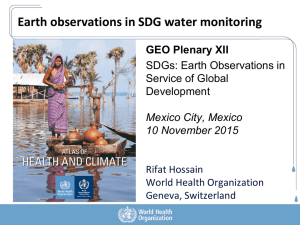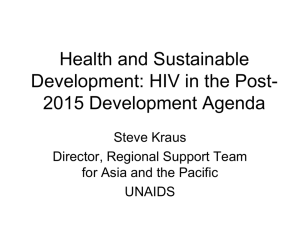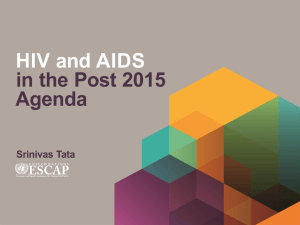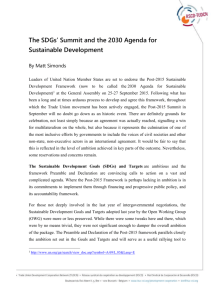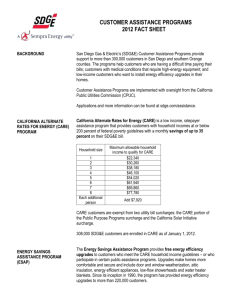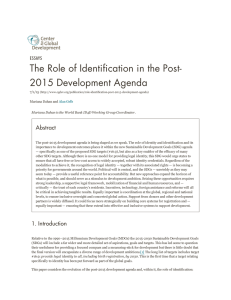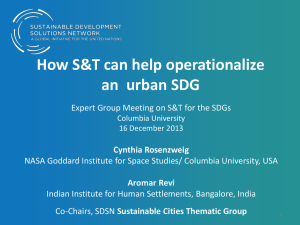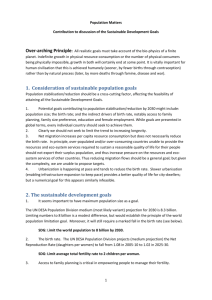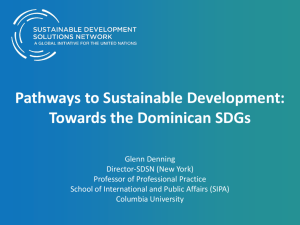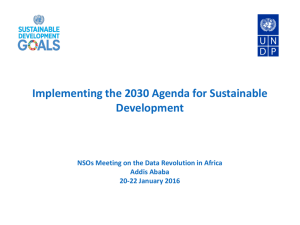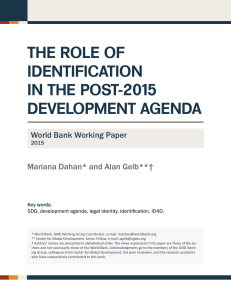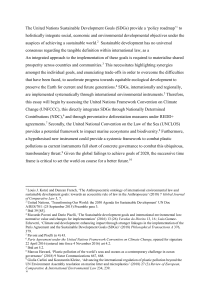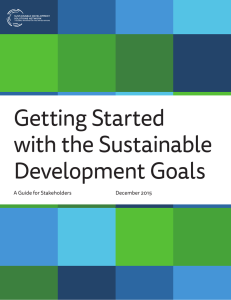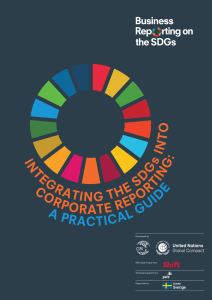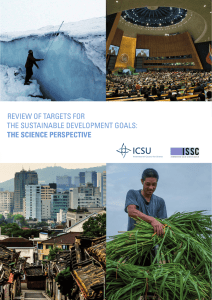Matrix on SDG Support Needs and Options in the ECA region
advertisement
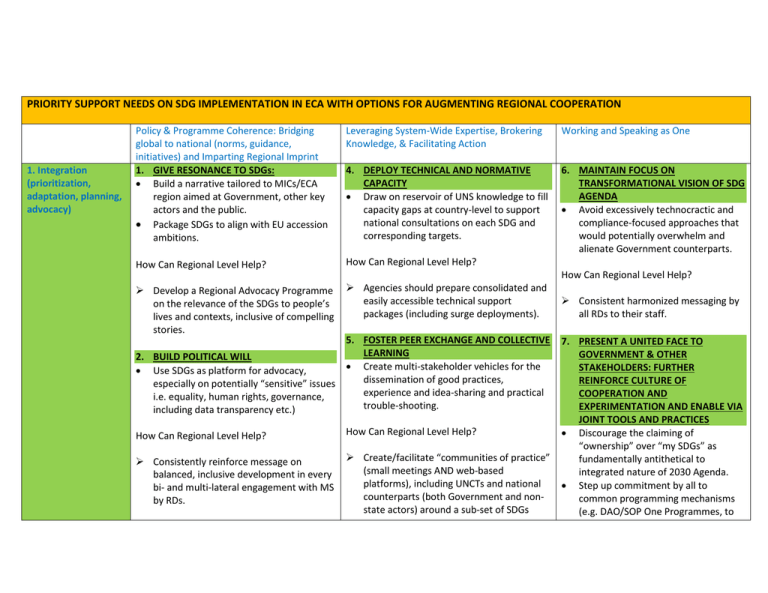
PRIORITY SUPPORT NEEDS ON SDG IMPLEMENTATION IN ECA WITH OPTIONS FOR AUGMENTING REGIONAL COOPERATION 1. Integration (prioritization, adaptation, planning, advocacy) Policy & Programme Coherence: Bridging global to national (norms, guidance, initiatives) and Imparting Regional Imprint 1. GIVE RESONANCE TO SDGs: Build a narrative tailored to MICs/ECA region aimed at Government, other key actors and the public. Package SDGs to align with EU accession ambitions. Leveraging System-Wide Expertise, Brokering Knowledge, & Facilitating Action Working and Speaking as One 4. DEPLOY TECHNICAL AND NORMATIVE CAPACITY Draw on reservoir of UNS knowledge to fill capacity gaps at country-level to support national consultations on each SDG and corresponding targets. 6. MAINTAIN FOCUS ON TRANSFORMATIONAL VISION OF SDG AGENDA Avoid excessively technocractic and compliance-focused approaches that would potentially overwhelm and alienate Government counterparts. How Can Regional Level Help? How Can Regional Level Help? Develop a Regional Advocacy Programme on the relevance of the SDGs to people’s lives and contexts, inclusive of compelling stories. Agencies should prepare consolidated and easily accessible technical support packages (including surge deployments). How Can Regional Level Help? 5. FOSTER PEER EXCHANGE AND COLLECTIVE LEARNING 2. BUILD POLITICAL WILL Create multi-stakeholder vehicles for the Use SDGs as platform for advocacy, dissemination of good practices, especially on potentially “sensitive” issues experience and idea-sharing and practical i.e. equality, human rights, governance, trouble-shooting. including data transparency etc.) How Can Regional Level Help? How Can Regional Level Help? Consistently reinforce message on balanced, inclusive development in every bi- and multi-lateral engagement with MS by RDs. Create/facilitate “communities of practice” (small meetings AND web-based platforms), including UNCTs and national counterparts (both Government and nonstate actors) around a sub-set of SDGs Consistent harmonized messaging by all RDs to their staff. 7. PRESENT A UNITED FACE TO GOVERNMENT & OTHER STAKEHOLDERS: FURTHER REINFORCE CULTURE OF COOPERATION AND EXPERIMENTATION AND ENABLE VIA JOINT TOOLS AND PRACTICES Discourage the claiming of “ownership” over “my SDGs” as fundamentally antithetical to integrated nature of 2030 Agenda. Step up commitment by all to common programming mechanisms (e.g. DAO/SOP One Programmes, to 3. CONTEXTUALIZE GLOBAL GUIDANCE AND ADDRESSING “STICKY” QUESTIONS How to build an SDG implementation roadmap (including sequencing). What are expectations on countries for tackling the breadth of SDG agenda (appropriate level of ambition across the goals, as well as within them). How should SDGs be costed at national level. How Can Regional Level Help? Conduct review of MAPS, UNITAR Modules (and other global guidance when forthcoming e.g. re human rights, universality etc.) from a regional perspective and identify ways and means/tools for tailoring to regional context (this could be done by and SDGfocused PAG-type mechanism) and/or sub-regions (could feed into tailoring MAPS to regional needs). which agencies must lend managerial, technical and financial resources). Empower UNCTs to find creative and context-appropriate solutions, within broad parameters of the SDG Outcome Document, and global guidance. How Can Regional Level Help? Provide an updated understanding of different agencies’ respective approaches and spheres of action on SDGs, establish clarity on division of labor, identify opportunities for synergy, and promote harmonized approaches. Hold regional UN-wide dialogues on key thematic priorities to drill down, in planning and operational terms, on how the UNS in ECA will achieve key objectives. Build and expand on the very positive experience with the PSG during the 2015 UNDAF Roll-Out Process by establishing a mechanism such as the PAG dedicated to timely provision of support on SDG Implementation, with clear leadership and focal point structure. Intensify communication by all RDs of joint guidance and key messages to their field Representatives to ensure uniformity of understanding. 8. ESTABLISH COMMON APPROACHES AND COORDINATION MECHANISMS AROUND THE “TRANSVERSAL” SDGs SDGs 1, 10, 16, 5, and 13 present particular difficulties for UN systemwide alignment/division of responsibilities among agencies. 9. ADAPT AND AUGMENT REGIONAL COORDINATION STRUCTURES TO SDG REQUIREMENTS Strategically add thematic groups on priority regional challenges (mirroring country-level arrangements); with balanced leadership across all entities and direct access by RCs/UNCTs to the Working Group leads. 2. Partnerships and Resource Mobilization/Transfer 1. FINANCE NATIONAL SDG ACTION Support Government in domestic and international resource mobilization and evidence-based decisions on resource allocation/budgeting. How Can Regional Level Help? Use regional structures and convenings to raise funds for multi-country thematic SDG programmes; Deployment of capacity building support in planning and RBM Promoting and enabling access to innovative finance 3. PROMOTE MULTISTAKEHOLDER ISSUESBASED APPROACHES Transcend mandate-based approaches by establishing at regional level multistakeholder thematic partnerships focused on global and regional public goods, possibly modelled after, and tapping into, global issue coalitions (e.g. Every Woman, Every Child and SE4A), and linked to country level; identify modes of outreach and engagement between the regional coordination mechanisms and non-UN partners. Facilitating and leveraging cross-border private development financing flows 2. FINANCE UN SUPPORT TO SDG IMPLEMENTATION Meet resource requirements for a range of UN activities, including awareness raising, advocacy, localization, integrated policy and programme design, the disaggregation of and collection of reliable data, establishment of genderresponsive monitoring systems, technical support and capacity building, and multistakeholder engagement. How Can Regional Level Help? Promote, create and manage pooled funding mechanisms for SDG action in the region. Promote cost-sharing for UN support of SDG roadmaps and DaO/SOP One Programmes. 3. Data, Monitoring, Follow-Up and Review 1. DEFINE NATIONAL INDICATORS AND SETTING BASELINES Urgent guidance on flexibility of countries in defining target and indicators (to ensure comparability for assessment of global progress). Given how inextricable dialogue on targets is from the availability of 4. PROMOTE EAST-EAST (SOUTH-SOUTH) AND TRIANGULAR COOPERATION Pool resources and knowledge through partnerships between traditional donors, emerging donors, and ODA recipients in the ECA region. 5. GUIDANCE ON OPERATIONALIZING PARTNERSHIPS AND LEVERAGING Clarity on expectation and parameters for, and approaches to, working with the private sector, and civil society, starting with awareness-raising. Technical guidance on (and financial support for) facilitation of multistakeholder dialogue and action platforms. Guidance on how to engage NGOs around SDG 16 in complex political environments. 6. OPERATIONALIZE THE UNIVERSALITY PRINCIPLE Unpack and clarify UN regional role in engagement with countries with no operational presence (for entities with mandate to do so). 4. PROVIDE TECHNICAL SUPPORT Extensive capacity building needs exist on data, measurement, monitoring and review for government (national statistical systems) and non-state actors, including on innovations (e.g. real-time monitoring, citizen-engagement, etc.). 5. HARMONIZE APPROACHES TO SDG MEASUREMENT AND MONITORING Urgent need for joined-up approaches when interfacing with respective line ministries re SDGs measurement and monitoring. indicators, the Global SDG Indicator Framework should be tapped into now, with a focus on those areas where there is agreement, rather than wait for full panoply in March 2016. 2. PROVIDE METHODOLOGICAL GUIDANCE Guidance/clarification regarding reporting requirements (including, periodicity, mechanisms, etc.), and provision of templates/integrated tools, and capacity building support. How Can Regional Level Help? DESA and UNECE in particular looked to for the development of clear indicators and methodological guidance on setting baselines, assessing/building national statistical capacity, etc. PSG could facilitate technical assistance in defining national indicators and linking these to UN planning and monitoring frameworks. 3. ESTABLISH REVEW AND FOLLOW-UP MECHANISMS Clarify expectations and systems for review and follow-up at country level and how these link to regional and global processes.
